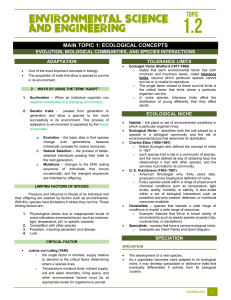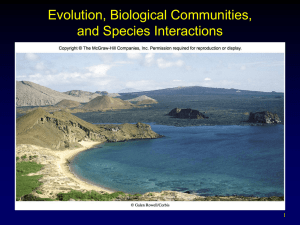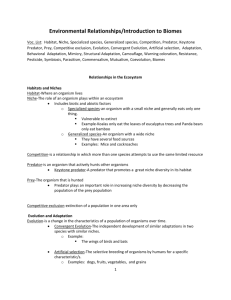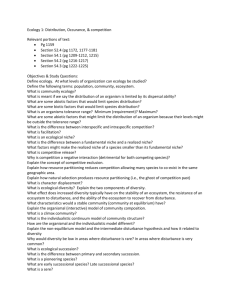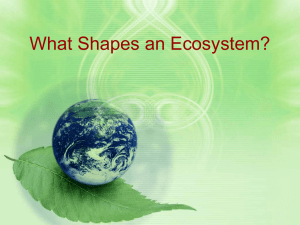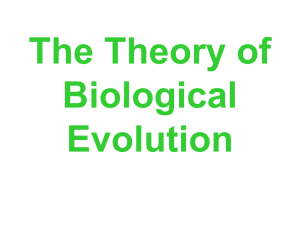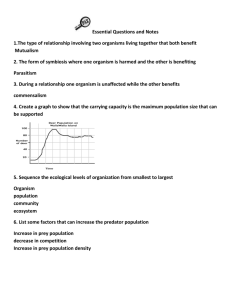File
advertisement
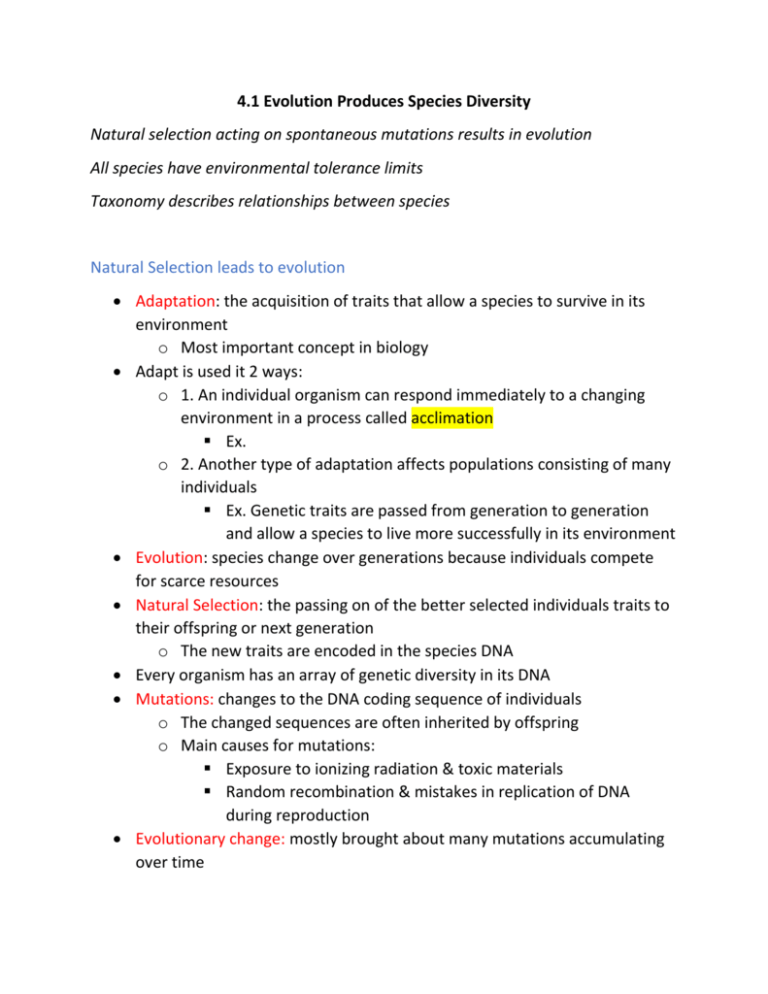
4.1 Evolution Produces Species Diversity Natural selection acting on spontaneous mutations results in evolution All species have environmental tolerance limits Taxonomy describes relationships between species Natural Selection leads to evolution Adaptation: the acquisition of traits that allow a species to survive in its environment o Most important concept in biology Adapt is used it 2 ways: o 1. An individual organism can respond immediately to a changing environment in a process called acclimation Ex. o 2. Another type of adaptation affects populations consisting of many individuals Ex. Genetic traits are passed from generation to generation and allow a species to live more successfully in its environment Evolution: species change over generations because individuals compete for scarce resources Natural Selection: the passing on of the better selected individuals traits to their offspring or next generation o The new traits are encoded in the species DNA Every organism has an array of genetic diversity in its DNA Mutations: changes to the DNA coding sequence of individuals o The changed sequences are often inherited by offspring o Main causes for mutations: Exposure to ionizing radiation & toxic materials Random recombination & mistakes in replication of DNA during reproduction Evolutionary change: mostly brought about many mutations accumulating over time Selection Pressures: the result in a species population that differs from those of numerous preceding generations All species live within limits Environmental factors: exert selection pressure & influence the fitness of individuals & their offspring o Because of this species are limited in where they can live Limiting factors: o 1. Physiological stress due to inappropriate levels of some critical environmental factor, such as moisture, light, temperature, pH or specific nutrients o 2. Competition with other species o 3. Predation, parasitism & disease o 4. And LUCK For example when an individual organism find their way to a new habitat and start a new population is simply luck rather than they are more fit An organisms physiology and behavior allow it to survive only in CERTAIN environments There must be certain factors at certain levels in order for the organism to survive Critical factor: (the single factor in shortest supply relative to demand) Chemist Justus von Liebig found this out o Ex. The giant saguaro cactus Later ecologist Victor Shelford expanded Liebig by stating that each environmental factor has both minimum & maximum levels called TOLERANCE LIMITS beyond which an a particular species cannot survive or is unable to reproduce The single factor closest to survival limits is the critical factor that limits where a particular organism can live Indicators: the requirements and tolerances of specific environmental characteristics o The presence or absence of species indicates something about the community & the ecosystem as a whole The ecological niche is a species’ role and environment Habitat: place or set of environmental conditions in which a particular organism lives Ecological niche: the role played by a species in a biological community & the set of environmental factors that determine its distribution o Niche first defined by ecologist Charles Elton To Elton each species has a role in a community of species & the niche defined its way of getting food, the relationship it had with other species, and the services it provided to its community o 30 years later G.E Hutchinson proposed a more physical and biological definition of the word niche Every species exists within a range of physical and chemical conditions, (temperature, light levels, acidity, humidity, & salinity Also exists within a set of biological interactions such as the presence of predators or prey, or the availability of nutritional resources Generalists: species who tolerate a wide range of conditions or exploit a wide range of resources o They have large geographic ranges Specialists: species who have a narrow ecological niche (do not tolerate environmental change well) o Ex. Panda Endemic species: (most often specialists) they occur only in one area or one type of environment In most organisms their genetic traits and instinctive behaviors restrict their ecological niche The principle of competitive exclusion: no 2 species can occupy the same ecological niche for long o The species that is more efficient in using available resources will exclude the other Resource partitioning: when species disappear or develop a new niche, exploiting resources differently o Partitioning can also allow several species to utilize different parts of the same resource and coexist within a single habitat o Resources can be partitioned in time as well as space Ex. Speciation maintains species diversity As population becomes more adapted to its ecological niche it may develop specialized or distinctive traits that eventually differentiate it entirely from its biological cousins Speciation: development of a new species Geographic isolation: Allopatric speciation: speciation that occurs when populations are geographically separated Behavioral isolation: Sympatric speciation: speciation that occurs within one geographic area o Ex. Directional slection: o Ex. can be observed in the emergence of antibiotic- resistant bacteria Stabilizing selection: reduce variation in a trait Disruptive selection: can cause traits to diverge to the extremes New environmental conditions lead to speciation as new opportunities become available Geological time is marked by periods of tremendous diversification that have followed the sudden extinctions of species Taxonomy describes relationships among species Taxonomy: the study of types of organisms and their relationships o With it you can trace how organisms have descended from common ancestors Taxonomic relationships among species are displayed like a family tree Binomials: they identify and describe species using Latin nouns and adjectives or names of peoples or places o Scientists communicate about species using these scientific names rather than their common names Taxonomy also helps describe specimens and subjects in museum collections & research Scientists recognize six kingdoms: o Animals o Plants o Fungi o Protists o Bacteria o And archaebacteria Within these kingdoms are millions of different species 4.2 Species Interactions shape biological communities Competition leads to resource allocation Predation is an important type of selective pressure Symbiosis benefits both species involved Competition leads to resource allocation Intraspecific competition: competition among members of the same species Interspecific competition: competition between members of different species for resources Competition shapes species population and biological communities by causing individuals and species to shift their focus from one segment of a resource type of another Ways to reduce competition in a species population o The young of the year disperse Seeds being carried elsewhere by the wind o Exhibiting strong territoriality Ex. Many animals force their offspring and competing adults from their vicinity This minimizes competition between individuals and generations o Resource partitioning between generations Ex. Adults and juveniles of this region occupy different ecological niches Many animals try to avoid fighting for resources and instead confront each other with noise and movements Each species has its tolerance limits for abiotic (non-living) factors Studies show that when two species compete 2 species compete the 1 living in the middle of its tolerance limits has the advantage and usually prevails in competition with other species living outside its environmental conditions Predation affects species relationships Predator: any organism that feeds directly on another living organism o Whether or not it kills the prey (carnivores, herbivores, and omnivores) Predation: Predation affects: o All stages in the life cycle of predator and prey species o Many specialized food-obtaining mechanism o The evolutionary adjustments in behavior and body characteristics that help prey avoid being eaten and help predators find food more easily Predator-mediated competition: in this a superior competitor in a habit builds up a larger population than the competing species o Allows weaker competitors to increase their numbers Predatory relationships may change as the life stage of an organism changes o Ex. (page 84) Some adaptations help avoid predation Coevolution: the response of predator to prey and vice versa over thousands of years produces physical and behavioral changes in this process o Can be mutually beneficial Batesian mimicry: certain species that are harmless resemble poisonous or harmful ones to keep predators away Mullerian mimicry: involves 2 unpalatable or dangerous species who look alike o When predators learn to stay away from that species they both benefit Symbiosis involves intimate relations among species Symbiosis: two or more species live intimately together with their fates linked o These types of relationships often enhance the survival of one or both partners Mutualism: when organisms combine to mutually benefit Commensalism: a type of symbiosis in which one member clearly benefits and the other is neither benefited or harmed Paratism: a form of predation o Can also be considered symbiosis because dependency of parasite on host Mutualistic relationships often entail some degree of coevolution where partners change together o Ex. Moths Keystone species have disproportionate influence Keystone species: plays critical role in a biological community that is out of proportion to its abundance o Keystone species tend to be more common in aquatic habits than in terrestrial ones 4.3 Community Properties Affect Species and Populations Productivity is a measure of biological activity Abundance and diversity measure the number and variety of organisms Resilience and stability make communities resistant to disturbance Productivity is a measure of biological activity Primary productivity: a communities rate of biomass production o An indication of the rate of solar energy conversion to chemical energy Net primary production: the energy left after respiration Light levels, temperature, moisture, and nutrient availability help regulate PHOTOSYNTHETIC RATES Only a small percentage of the available sunlight is captured and used to make energy-rich compounds o Only 0.1 to 0.2% of the absorbed energy is used by chloroplasts to synthesize carbohydrates Abundance and diversity measure the number and variety of organisms Abundance: an expression of the total number of organism in a biological community Diversity: a measure of the number of DIFFERENT species, ecological niches, or genetic variation present The abundance of a particular species is often inversely related to the total diversity of the community o General rule- diversity decreases but abundance within species increases as we go from the equator toward the poles Productivity is related to abundance and diversity because they are both dependent on the total resource availability in an ecosystem as well as the reliability of resources, the adaptations of the member species and the interaction between species Ways a community may not be perfectly adapted to their environment: o A new community who hasn’t had time for niche specialization o A disturbed community where roles such as top predator are missing Community structure is the spatial distribution of organisms Ecological structure: refers to patterns of spatial distribution of individuals and populations within a community as well as the relation of a particular community to its surroundings At local level, even in homogenous environments, individuals in a single population can be distributed randomly or in highly regular patterns, or clumped together o In randomly arranged populations individuals live wherever resources are available o Ordered patterns may be determined by the physical environment but are more often the result of biological competition Ex. Many aquatic communities are stratified into layers based on light penetration in the water, temperature, salinity, pressure, and other factors Complexity and Connectedness are important ecological indicators Community complexity and connectedness are related to diversity o Important because they help us visualize and understand community functions Complexity: refers to the number of species at each trophic level and the number of trophic levels in a community o A diverse community may not be very complex if all species are clustered together in only a few trophic levels and form a relatively simple food chain o A complex, highly interconnected community might have many trophic levels some of which can be compartmentalized into subdivisions Resilience and stability make communities resistant to disturbance Constancy: lack of fluctuations in compositions or functions Inertia: resistance to perturbations Renewal: ability to repair damage after disturbance Edges and boundaries are the interfaces between adjacent communities The boundary between one habitat and its neighbors is an important aspect of community structure…these relationships are called EDGE EFFECTS Ecotones: the boundaries between adjacent communities Community that is sharply divided from its neighbors is called a closed community Open communities: gradual or indistinct boundaries over which many species cross 4.4 Communities are dynamic and change over time Some biological communities are dependent on periodic disturbance Introduced species can cause profound community change The nature of communities is debated Communities develop in a series of stages o Starting either from bare rock or after a severe disturbance Climax community: species replace each other in predictable groups and in a fixed, regular order o Maximum complexity and stability that was possible Ecological succession is the history of community development Primary succession: land that is bare of soil is colonized by living organisms where none lived before Secondary succession: when an existing community is disturbed a new one develops from the biological legacy of the old o In both successions organisms change the environment by modifying soil, light levels, food supplies, and microclimate Ecological development or facilitation: This change permits new species to colonize and eventually replace the previous species Pioneer species: (microbes, mosses, and lichens) that can withstand a harsh environment with few resources o When they die the bodies of pioneer species create patches of organic matter As succession continues, the community now becomes more diverse and interspecies competition arises Pioneer species disappear as the environment favors new colonizers that have competitive abilities more suited to the new environment Secondary succession is all around us o In abandoned farms o Clear cut forests o & in disturbed suburbs or lots Generalists figure prominently in early succession Long periods of community development lead to greater community complexity, high nutrient conservation and recycling, stable productivity, & great resistance to disturbance Appropriate disturbances can benefit communities Disturbance: any force that disrupts the established patterns of species diversity and abundance, community structure, or community properties o Animals can causes disturbance Ex. Elephants Aboriginal populations have disturbed and continue to disturb communities around the world Breaking the grip of a super-competitor is the helpful role disturbances often play Disturbance-adapted species: landscapes that never reach a stable climax in a traditional sense because they are characterized by periodic disturbances and are made up of species DISTURBENCE ADAPTED SPECIES that survive fires underground, or resist the flames, and then reseeds quickly Introduces species can cause profound community change Succession requires the continual introduction of new community members and the disappearance of previously existing species o New species move in as conditions become suitable o Other die or move out as the community changes o New species can also be introduced after a stable community has already become established If however an introduced species preys upon a or outcompetes one or more of the populations living in that community the entire nature of the community can be altered Prolific: Sometimes we introduce new species thinking it will make the problem we are facing go away but in reality we are making it worse!!!! o Ex. Mongoose on Hawaii
